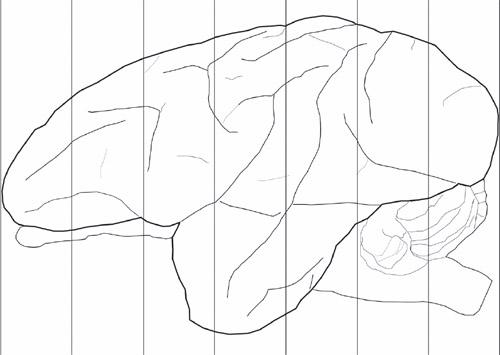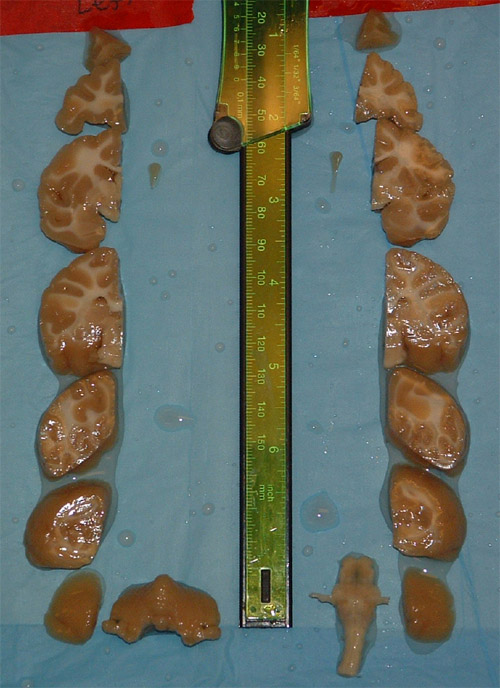A subscription to JoVE is required to view this content. Sign in or start your free trial.
Method Article
Dissecting the Non-human Primate Brain in Stereotaxic Space
In This Article
Summary
The non-human primate is an important translational species for our understanding of the normal processing of the brain. The anatomical organization of the primate brain can provide important insights into normal and pathological conditions in humans.
Abstract
Protocol
Part 1: Pre-processing of tissue
- Tissue should be well perfused with paraformaldehyde, glutaraldehyde, or formalin. This can be achieved through standard transcardial perfusion typically used to harvest other organs. In the present study the subject was deeply sedated with ketamine hydrochloride (10 mg/kg, i.m.), euthanized with an overdose of sodium pentobarbital (25 mg/kg, i.v.) and perfused transcardially with 0.1 M PBS until completely exsanguinated.This is followed by a 4% paraformaldehyde solution in PBS for 5 min (~1 liter).
Part 2: Stereotaxic blocking
- Prior to placing the head into the stereotaxic frame the coordinates of the Horsley-Clarke/interaural plane zero needs to be taken. This is the theoretical midpoint between the ears. To measure this plane, the ear bars need to be equally fitted in the apparatus, then place a scalpel blade in the stereotaxic manipulator arm and measure the midpoint between the ear bars. This is important for determining where to block the tissue based on research needs. Once this is completed the skull needs to be prepared for fixation into the stereotaxic apparatus.
- In order to place the head into the stereotaxic frame the lower jaw will have to be removed with bone rongeurs and a scalpel. Additionally the skin, muscle, and connective tissue should be removed in order to expose the skull. Once the connective tissue is removed from the skull, expose the brain by chipping away the calvaria (the tabular portion of the occipital bone as well as the parietal, ad frontal bones). In the present experiment part of the calvaria has all ready been removed. Be careful not to completely remove the temporal bones because the ear canals will need to be intact to place the head into the stereotaxic frame. The remaining dura matter should be removed from the exposed brain. The skull is now ready to be placed into the stereotaxic frame.
- In the same manner in which one would perform a stereotaxic surgery, adjust the eye, palate, and ear bars such that the head is securely fixed in the stereotaxic apparatus. Place the stereotaxic manipulator in the predetermined anterior/posterior (A/P) coordinates and move the manipulator to the lateral aspect of the brain. Slowly lower the blade into the brain, completely raise the blade from the brain, then move medially and lower the blade again. Repeat these two steps until the blade has reached the lateral aspect of the opposite hemisphere. This completes the first coronal block. For subsequent coronal blocks move the manipulator 1cm in the A/P axis and repeat until the entire brain has been blocked.
Part 3: Removing the brain from the skull
- Remove the head from the stereotaxic frame and hold the exposed brain in the palm of your hand. Try to secure the brain by lightly placing coddling the brain in the palm of your hand and place your pinky finger across the frontal lobes, this minimizes movement of the brain in the skull. In order to prevent the drying of the pial surface of the brain, place a piece of PBS dampened gauze across the brain. Hold the head firmly by the skull and chip away the remaining occipital and temporal bones along with the spinal column. This exposes the base and lateral aspects of the brain. Lastly remove any remaining frontal bone and the nasal bone, which will allow access to the olfactory bulbs. It is important to remove the frontal bone last because as you remove the base of the skull the brain moves slightly and the frontal lobes can become damaged on the jagged edges of the fontal bone. Cut away and remove remaining dura matter. Carefully lift the front of the brain, slide the scalpel under the brain and free the brain from the skull.
Part 4: Measurements
- There are a number of useful measurements that can be made prior to freezing. For example, the A/P axis of the brain with a caliper. Furthermore the specific density can be measured by weighing the brain, measuring volume by the displacement of water in a graduated cylinder then dividing weight by volume displacement (Table 1).
Part 5: Finish blocking the brain.
- Typically when the scalpel blade is inserted into the brain it is not long enough to completely penetrate the full dorsal-ventral extent of the brain. Once the brain is removed and gross measurements are obtained, take a tissue-slicing blade and finish blocking the brain through to the ventral side of the brain (Figure 2).
- Prior to freezing the blocks, it is necessary to cryoprotect the tissue in graded PBS-buffered sucrose solutions (10, 20, and 30%) maintained at 4˚C until the brain sinks. It typically takes an overnight incubation in 10%, 2-3 days in 20% and additional 3-5 days in 30% for the blocks to sink to the bottom of the container. A daily change of the 30% sucrose solution is recommended.
Part 6: Representative Results
There are a number of gross morphological measurements that can be made once the brain has been removed from the skull. These include A/P length, weight, and specific density (Table 1). We generally block the brain into 6-7 blocks measuring 1cm (Figure 1). Each piece is then photographed (Figure 2) and can be further dissected depending on research needs or prepared for freezing in graded sucrose solutions.
Subject | A/P Length (mm) | Weight (grams) | Water Displacement (ml) | Specific Density (g/ml) |
| O2303-2-1-1 | 64.3 | 28.1 | 24 | 1.171 |
| O5180-1 | 71.3 | 38.7 | 34 | 1.138 |
| O2708-3-1 | 62.8 | 28.7 | 26 | 1.104 |
| O9184-4-2 | 65.3 | 29.5 | 24 | 1.229 |
| N459-1-14-2 | 68.2 | 31.6 | 26 | 1.215 |
| AVERAGE | 66.38 | 31.32 | 26.8 | 1.171 |
| STD DEV | 3.38 | 4.33 | 4.17 | 0.052 |
Table 1. Gross Morphological Measurements of the Right Hemisphere of 5 Month Old Vervets


Figure 1. Schematics for the coronal planes used for blocking the brain. This is an example of an externalized adult vervet brain. Example of the blocking procedure. The vertical lines here are spaced at 1cm, typically producing 7 coronal blocks from each hemisphere.

Figure 2. Blocks of brain tissue in stereotaxic space.Each block will yield approximately 200 sections taken at 50µm. With this sampling scheme over 1200 sections through the cortex will be taken and an additional 400-500 from the cerebellum when sliced in the coronal plane.
Access restricted. Please log in or start a trial to view this content.
Discussion
The St. Kitts vervet (Chlorocebus aethiops sabeus) is an Old World primate with similar patterns and rates of cortical and subcortical brain development to that of humans. This species has been used to model complex human behavioral disorders like anxious behavior, hypertension8, hemispherectomy9, Parkinson’s disease10, Alzhemier’s disease11, and alcohol abuse12. More recently, this species has been used to study the neuroanatomical effects of na...
Access restricted. Please log in or start a trial to view this content.
Disclosures
The authors have nothing to disclose.
Acknowledgements
The authors would like to thank Ikiel Ptito for his continued technical support. NSERC grant to MP.
Access restricted. Please log in or start a trial to view this content.
Materials
| Name | Company | Catalog Number | Comments |
| Scalpel | Fine Science Tools | 10003-12 | |
| Scalpel blades | Fine Science Tools | 10011-00 | |
| Scissors | Fine Science Tools | 14090-11 | Any surgical scissors are sufficient |
| Rongeurs | Fine Science Tools | 16121-14 | |
| Forceps | Fine Science Tools | 11027-12 | |
| Filter paper | Fisher Scientific | 09-924-150 | |
| Stereotaxic Frame | Kopf Instruments | ||
| Tissue slicing blade | Thomas Scientific |
References
- Gallagher, M., Rapp, P. R. The use of animal models to study the effects of aging on cognition. Annu Rev Psychol 48. , 339-370 (1997).
- Clancy, B., Darlington, R., Finlay, B. Translating developmental time across mammalian species. Neuroscience. 105, 7-17 (2001).
- Nowakowski, R. S., Rakic, P. The site of origin and route and rate of migration of neurons to the hippocampal region of the rhesus monkey. J Comp Neurol. 196, 129-154 (1981).
- Rakic, P., Bourgeois, J. P., Eckenhoff, M. F., Zecevic, N., Goldman-Rakic, P. S. Concurrent overproduction of synapses in diverse regions of the primate cerebral cortex. Science. 232, 232-235 (1986).
- Granger, B., Tekaia, F., Le Sourd, A. M., Rakic, P., Bourgeois, J. P. Tempo of neurogenesis and synaptogenesis in the primate cingulate mesocortex: comparison with the neocortex. J Comp Neurol. 360, 363-376 (1995).
- Zecevic, N., Rakic, P. Development of layer I neurons in the primate cerebral cortex. J Neurosci. 21, 5607-5619 (2001).
- Ervin, F. R., Palmour, R. M., Young, S. N., Guzman-Flores, C., Juarez, J. Voluntary consumption of beverage alcohol by vervet monkeys: population screening, descriptive behavior and biochemical measures. Pharmacol Biochem Behav. 36, 367-373 (1990).
- Palmour, R. M., Mulligan, J., Howbert, J. J., Ervin, F. Of monkeys and men: vervets and the genetics of human-like behaviors. Am J Hum Genet. 61, 481-488 (1997).
- Boire, D., Théoret, H., Ptito, M. Stereological evaluation of neurons and glia in the monkey dorsal lateral geniculate nucleus following an early cerebral hemispherectomy. Exp Brain Res. 142, 208-220 (2002).
- Bjugstad, K. B., Teng, Y. D., Redmond, D. E. J. r, Elsworth, J. D., Roth, R. H., Cornelius, S. K., Snyder, E. Y., Sladek, J. R. Jr Human neural stem cells migrate along the nigrostriatal pathway in a primate model of Parkinson's disease. Exp Neurol. 211, 362-369 (2008).
- Lemere, C. A., Beierschmitt, A., Iglesias, M., Spooner, E. T., Bloom, J. K., Leverone, J. F., Zheng, J. B., Seabrook, T. J., Louard, D., Li, D., Selkoe, D. J., Palmour, R. M., Ervin, F. R. Alzheimer's disease abeta vaccine reduces central nervous system abeta levels in a non-human primate, the Caribbean vervet. Am J Pathol. 165, 283-297 (2004).
- Mash, D. C., Staley, J. K., Doepel, F. M., Young, S. N., Ervin, F. R., Palmour, R. M. Altered dopamine transporter densities in alcohol-preferring vervet monkeys. Neuroreport. 7, 457-462 (1996).
- Burke, M. W., Palmour, R. M., Ervin, F. R., Ptito, M. Neuronal reduction in frontal cortex of primates after prenatal alcohol exposure. Neuroreport. 20, 13-17 (2009).
Access restricted. Please log in or start a trial to view this content.
Reprints and Permissions
Request permission to reuse the text or figures of this JoVE article
Request PermissionExplore More Articles
This article has been published
Video Coming Soon
Copyright © 2025 MyJoVE Corporation. All rights reserved